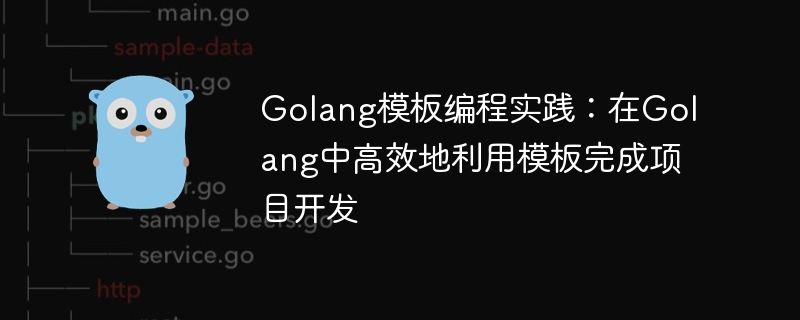Golang模板编程实践:利用模板高效完成Golang项目开发
- PHPz原创
- 2024-01-20 08:21:061192浏览

Golang模板编程实践:利用模板高效完成Golang项目开发,需要具体代码示例
摘要:随着Golang在软件开发领域的不断发展,越来越多的开发者开始关注并使用Golang进行项目开发。在Golang中,模板编程是一个非常重要的技术,能够帮助开发者高效地完成项目开发。本文将介绍如何在Golang中利用模板进行项目开发,并提供具体的代码示例。
引言:
Golang是一门简洁、高效的编程语言,在Web开发和系统编程中非常受欢迎。Golang提供了内建的模板引擎,可以用于生成动态的HTML页面、电子邮件、文档等。利用Golang的模板编程技术,开发者能够快速创建和管理复杂的网页界面,并实现动态交互的效果。
一、Golang中的模板基础
在Golang中,模板被定义在text/template和html/template两个标准库中,分别用于处理纯文本和HTML文档。使用模板可以将静态内容和动态数据进行结合,生成最终的输出结果。
- 模板引擎基础语法
模板引擎的基本语法包含模板定义、变量定义、条件语句、循环语句等。下面是一个简单的例子:
package main
import (
"os"
"text/template"
)
type User struct {
Name string
Email string
}
func main() {
user := User{Name: "John", Email: "john@example.com"}
tmpl, err := template.New("userDetails").Parse("Name: {{.Name}}, Email: {{.Email}}
")
if err != nil {
panic(err)
}
err = tmpl.Execute(os.Stdout, user)
if err != nil {
panic(err)
}
}在上述例子中,我们定义了一个User结构体,包含名字和邮箱属性。然后,通过template包的New函数创建一个模板对象,使用Parse方法解析模板内容,最后利用Execute方法将数据应用到模板,并将结果输出到标准输出流。
- 模板文件的导入和组织
在实际的项目开发中,模板往往包含大量的内容。为了方便管理和维护,可以将模板内容保存在单独的文件中,然后通过ParseFiles或ParseGlob方法加载模板文件。下面是一个示例代码:
package main
import (
"os"
"text/template"
)
type User struct {
Name string
Email string
}
func main() {
user := User{Name: "John", Email: "john@example.com"}
tmpl, err := template.ParseFiles("templates/user.html")
if err != nil {
panic(err)
}
err = tmpl.Execute(os.Stdout, user)
if err != nil {
panic(err)
}
}在上述例子中,我们将模板保存在"templates/user.html"文件中,然后通过ParseFiles方法加载模板文件。最后,通过Execute方法将数据应用到模板,并输出到标准输出流。
二、模板编程高级技巧
除了基本的模板语法外,Golang还提供了一些高级的模板编程技巧,例如模板函数、流程控制等。下面将介绍其中的一些常用技巧。
- 模板函数
模板函数可以帮助我们对数据进行处理和格式化。Golang的模板引擎内置了一些常用的函数,例如字符串处理函数、日期时间函数、数值计算函数等。另外,我们还可以自定义模板函数来满足特定的需求。下面是一个示例代码:
package main
import (
"os"
"text/template"
"strings"
)
type User struct {
Name string
Email string
}
func ToUpper(s string) string {
return strings.ToUpper(s)
}
func main() {
user := User{Name: "John", Email: "john@example.com"}
funcs := template.FuncMap{
"ToUpper": ToUpper,
}
tmpl := template.Must(template.New("").Funcs(funcs).Parse("Name: {{ToUpper .Name}}, Email: {{.Email}}
"))
err := tmpl.Execute(os.Stdout, user)
if err != nil {
panic(err)
}
}在上述例子中,我们定义了一个ToUpper函数,用于将字符串转换为大写。然后,通过FuncMap类型将ToUpper函数注册为模板函数,最后将函数应用到模板中。
- 流程控制
Golang的模板引擎还支持流程控制语句,例如if语句、range语句等。下面是一个示例代码:
package main
import (
"os"
"text/template"
)
type User struct {
Name string
Emails []string
}
func main() {
user := User{Name: "John", Emails: []string{"john@example.com", "john@gmail.com"}}
tmpl := template.Must(template.New("").Parse(`
Name: {{.Name}}
Emails:
{{range .Emails}}
- {{.}}
{{end}}
`))
err := tmpl.Execute(os.Stdout, user)
if err != nil {
panic(err)
}
}在上述例子中,我们使用range语句遍历用户的多个邮箱,并将邮箱逐个输出。
结论:
本文介绍了在Golang中进行模板编程的基础知识和高级技巧,包括模板的基本语法、模板文件的导入和组织、模板函数、流程控制等。通过合理地利用Golang的模板技术,开发者可以提高开发效率,并实现更加灵活和高效的项目开发。希望本文的内容能够对你在Golang项目开发中的模板编程实践有所帮助。
参考文献:
- Golang text/template 官方文档: https://golang.org/pkg/text/template/
- Golang html/template 官方文档: https://golang.org/pkg/html/template/
以上是Golang模板编程实践:利用模板高效完成Golang项目开发的详细内容。更多信息请关注PHP中文网其他相关文章!

